Patient empowerment is creating a shift in not only marketing but also clinical strategies for the industry. As patients take more control of their healthcare decisions and needs, they are inadvertently forcing the healthcare environment around them to change. As physicians evolve their approach to focus more on meeting the demands of information from digital savvy patients, and the demand for quality patient outcomes from payers, the life-sciences industry has started to follow suit. In the years to come, a focus on customer experience and engagement will become an increasingly larger portion of the value proposition for products and brands. To provide this value, the industry will need to up its game in terms of relationships, communication, and developing strategies that address the needs and expectations of today’s patients, as well as caregivers, providers, and payers.
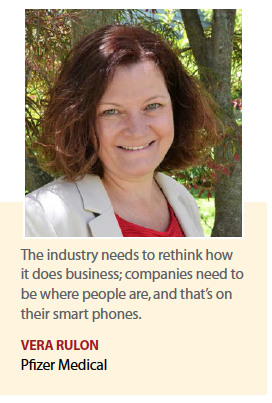 Patient engagement has been called the “Blockbuster Drug of the Century" because of its potential power, says Vera Rulon, director, external medical communications, Pfizer Medical.
Patient engagement has been called the “Blockbuster Drug of the Century" because of its potential power, says Vera Rulon, director, external medical communications, Pfizer Medical.
“This power stems fundamentally from access to information: information about a disease, about healthcare providers, treatments and medicines, and about personal health information," she says.
“The industry is starting to recognize that patients aren’t standing still, and are already re-defining the shift in the industry’s strategies, creating many intriguing examples of organizations re-orienting themselves to become more patient centric."
There are several new themes running through the patient-centric dialogue, including knowledge sharing, patient programs, and new research techniques. Silos need to be eliminated, integration and partnering will be key, and the buzzword “patient centric" will become not only a corporate philosophy, but also a solid business model.
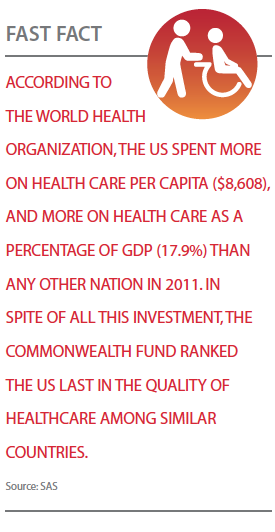 On the road to this evolution, the industry will want to focus on three basic tenets. To create an integrated approach to patient care and engagement, the industry needs to better understand the emotional insights and overall root causes for patient decisions.
On the road to this evolution, the industry will want to focus on three basic tenets. To create an integrated approach to patient care and engagement, the industry needs to better understand the emotional insights and overall root causes for patient decisions.
“We as pharma tend to focus and base our decisions on facts, data and science; however, patients’ decisions are often purely emotional," says Christine Sakdalan, VP, patient centric strategy and solutions, Novo Nordisk. “We need to shift our strategy to focus on the emotional insights into patients’ behavior, unmet needs, and the barriers to treatment."
Ms. Sakdalan says organizations are incorporating this focus into their strategies and business planning processes, and organizations, like Novo Nordisk, have made patient centricity more than a buzzword by incorporating an intentional focus and discipline into their organizational structures.
“At Novo Nordisk, while patient focus is an expectation with every employee as well as part of the Novo Nordisk Way, we have also decided to invest in having a dedicated team focused on improving patient care, education, engagement, and their overall experience," she says. “Some companies even have a chief patient officer or a chief experience and engagement officer."
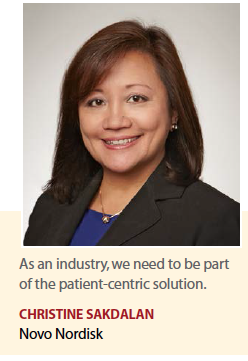 To bring more value to the patient experience, Ms. Sakdalan says the industry needs to help patients with tools that make their journey easier. Another place that serves as a benefit for patients is information around reimbursement.
To bring more value to the patient experience, Ms. Sakdalan says the industry needs to help patients with tools that make their journey easier. Another place that serves as a benefit for patients is information around reimbursement.
“When it comes to patient affordability, the more that we can provide transparency and healthcare literacy, the more value we can deliver," she says. “Everything we do is based on the journey of the patient. We focus on each phase of their journey, on their needs and desires, and on areas of their journey where we can make the most impact."
Many other companies have also started to provide patients with the right tools to help improve their outcomes — a big step in the right direction for patient-centric experience. Companies recognize the value of offering personalized information to help patients manage their diseases and adhere to their medications.
“Technology has played a huge role in helping to personalize information, giving patients more control over their health," says Ruchin Kansal, executive director and head, business innovation at Boehringer  Ingelheim Pharmaceuticals. “With this, we’ll continue to see the industry focusing on developing predictive models and clinical decision support tools to match right patients to the right medications.
Ingelheim Pharmaceuticals. “With this, we’ll continue to see the industry focusing on developing predictive models and clinical decision support tools to match right patients to the right medications.
Further, the industry will continue to invest in enhancing the patient experience through services and solutions, including investments in digital health tools and partnerships with health tech companies."
There are three important steps companies have been implementing to add substantial value to the patient consumer, says Sanjaya Shunglu, director of marketing, Infinity Pharmaceuticals. First, there has been broad and deep adoption of new data sources and advanced research methods to delve underneath stated patient needs. Second, companies have expanded efforts to educate the diverse constituents, helping them gain accurate and complete information as well as valuable input from their support network. And third, industry is taking rapid steps toward implementing information and support programs, along with resources that complement direct care teams, such as nurse hotlines, medical information websites, to help them make complex decisions that encompass both emotional and physical variables.
“The industry has taken these and other significant steps to be more patient-centric in its approach to providing patients the right info in a timely manner," Mr. Shunglu says.
Across healthcare communities, patients have made it clear in recent years that they want to play an active role in their care and make joint decisions with their doctor to manage their conditions in the way that works best for their individual needs. It is critical for companies to listen carefully and fully understand the patient journey so that they can deliver the kind of support patients are expecting.
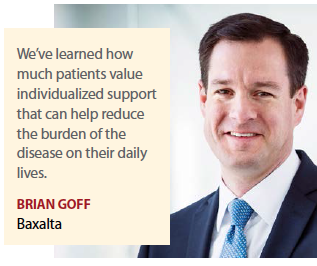 “At Baxalta, we place patient interests at the very center of all we do to ensure we’re delivering solutions and support that provide meaningful benefit," says Brian Goff, executive VP and president, hematology, Baxalta. “Through our many years of engagement with people in the hemophilia and rare diseases communities, for example, we’ve learned how much they value individualized support that can help reduce the burden of the disease on their daily lives. This is why we continually strive to improve our support programs to help them navigate their healthcare journey."
“At Baxalta, we place patient interests at the very center of all we do to ensure we’re delivering solutions and support that provide meaningful benefit," says Brian Goff, executive VP and president, hematology, Baxalta. “Through our many years of engagement with people in the hemophilia and rare diseases communities, for example, we’ve learned how much they value individualized support that can help reduce the burden of the disease on their daily lives. This is why we continually strive to improve our support programs to help them navigate their healthcare journey."
For example, Baxalta’s NAVA program — a personalized support website, call and live chat center available 24/7 for patients with hemophilia — offers educational resources and support, and access to peer advisors, others with hemophilia, who serve as useful resources truly understanding their journey.
“We believe that patient interests will continue to be an increasingly important part of the treatment decision process," Mr. Goff says. “Our focus on patient-inspired innovation and engagement programs will help us continue to improve our own offerings to better prepare patients to make informed decisions."
Other examples, offered up by Ms. Rulon, include the newly launched Get My Health Data Campaign whose aim is to empower patients through access to health information. This campaign is being coordinated by the National Partnership for Women and Families and has a wide range of sponsors.
Another example, Open Notes, which started at the Robert Wood Johnson Foundation, gives patients access to their doctors’ notes.
“While there was skepticism at first, both physicians and patients engaged in Open Notes have come to realize that being fully informed engenders trust and enables better care," Ms. Rulon says.
At Novo Nordisk, the company is focused on the patients’ experience, but also on their caregivers and allied healthcare professionals such as pharmacists, nurses, and PAs.
“We aim to improve on topics that are relevant to patients and HCPs such as affordability, cost, and burden of diabetes, and the overall impact to the healthcare system," Ms. Sakdalan says. “These are broader topics that affect the patient and increases the burden on them in general. We need to be part of the solution as an industry."
New Paradigms in Patient Centricity
There are several emerging trends that are creating new paradigms within the industry: new ways to research and understand the patient, increased knowledge sharing, and collaboration with patient advocacy groups.
At Janssen Research & Development, the company has developed a novel scientific approach, called disease interception, which seeks to address genetic susceptibility and environmental triggers in people at-risk of developing disease so that not only can it help patients living with the disease, but it can intervene earlier and prevent progression to disease. Called disease interception, the approach will integrate innovative science, novel therapeutics, precision diagnostics, and new business models to nurture solutions that intercept disease.
Janssen R&D’s first area of focus, T1D research, will use the rapidly emerging science of immune diagnostics and precision intervention to provide the foundation to intercept other diseases that have immunological underpinnings.
In addition to efforts in T1D, Janssen plans to pursue other disease areas that demonstrate great scientific opportunity, concentrating on diseases with high unmet need, where Janssen has deep expertise and understanding of emerging science, and where there are broader cross-disease applications for scientific learnings going forward.
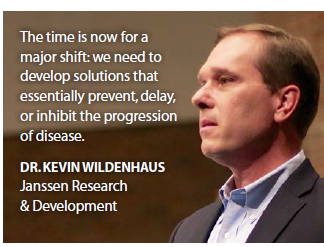 “The time is now for a major paradigm shift in our industry," says Dr. Kevin Widenhaus, behavioral science leader at Johnson & Johnson. “We need to prioritize efforts in developing Disease Interception solutions that essentially prevent, delay, or inhibit progression of disease as an integral part of the healthcare continuum. To make this shift from “diagnose-and-treat" disease-based care to “predict-and-preempt" health-based care will mandate a new model of teamwork."
“The time is now for a major paradigm shift in our industry," says Dr. Kevin Widenhaus, behavioral science leader at Johnson & Johnson. “We need to prioritize efforts in developing Disease Interception solutions that essentially prevent, delay, or inhibit progression of disease as an integral part of the healthcare continuum. To make this shift from “diagnose-and-treat" disease-based care to “predict-and-preempt" health-based care will mandate a new model of teamwork."
For consumers specifically, disease interception will require them to no longer be “patients" but active “participants" in their health, he says. They will need to own their good health, work collaboratively with their providers and embrace industry advances and emerging technologies for early screening and ongoing monitoring of disease risk.
Sharing information on diseases as well as products will become a new role for the industry, and a valued one, Ms. Rulon says.
“From a life-sciences perspective, patient-centric thinking means sharing information not only about our products and the research supporting them, but also about our knowledge base of diseases," she says. “Many people don’t realize that pharmaceutical companies have extensive, highly valuable bases of knowledge about diseases. Finding ways to share this knowledge will accrue to the benefit of patients and industry alike."
Digital communication has become a key tool for the industry to reach audiences and share information efficiently, Ms. Cohen says, especially when working with advocacy groups and patients. There is a renewed emphasis on two-way communication between advocacy groups and patients, and the industry, and working through patients’ trusted sources is beneficial to the industry. For example, many patient advocacy organizations are closely connected to the communities they serve and are keenly aware of challenges in the clinical trial process. These advocacy organizations have sophisticated communications channels, which can alert patients of medical research and help them identify trials most targeted to their disease.
“At Acorda, we’re partnering with research foundations and advocacy groups like the Michael J. Fox Foundation’s Fox Trial Finder to communicate the importance of research and to accelerate our clinical trials," Ms. Cohen says.
Also, industry and regulators are leveraging patient-reported outcomes to evaluate therapeutic benefit and improve clinical trial design. The idea of incorporating patient perspectives into the drug development process has been gaining momentum with programs like the FDA’s Patient-Focused Drug Development program and the Clinical Trials Transformation Initiative.
Patient-Centric Research
More productive collaboration between patient groups and sponsors will lead to more efficient and quality-driven data, but the industry needs to revamp its patient research practices to best understand the empowered patient and his or her behaviors. Continuing to work closely with patient advocacy groups can help biotech companies gather better data on the patient experience.
“These organizations have intimate connections to patients, families, and physicians, and the insights we need to inform our understanding of the patient journey," Ms. Cohen says. “Five years ago, the extent of biotech’s involvement with patient groups was limited, but with the new emphasis on patient-focused drug development and through initiatives like the 21st Century Cures Act, patient groups have more influence across the development continuum."
Research can only be truly useful if it is responding to a relevant unmet patient need; therefore, early and consistent patient engagement in the clinical research process is critical to design and deliver new offerings that provide truly meaningful benefit and improve lives, Mr. Goff says. In recent years, Baxalta has delivered a number of new therapies, improved and simplified tools for administration and developed new patient resources in direct response to feedback from its communities.
“We have been engaged with the hemophilia community for more than 60 years, and in that time, have learned a lot about what patients and their caregivers value, and how they want to manage their condition," he says. “This dialogue is what drives our ongoing innovation — we are gaining feedback on the most pressing unmet needs and are actively responding with new strategies and therapies that can help relieve the burden of these conditions."
Understanding the patient’s mindset through benefit-risk assessment can help biotech companies and regulators tailor clinical trial design, identify potential therapeutic risks, and define meaningful treatment benefits. Developing appropriate scientific methodologies for assessing patient views on disease burden can be translated into new and effective drug development tools, such as qualified patient-reported outcomes and biomarkers.
Acorda Therapeutics used patient feedback to determine the primary focus for outcomes for its multiple sclerosis treatment.
“It was only through reaching out and interviewing people who had been in our early phase studies, and in working with patient advocacy groups to access patients in their networks, that we eventually settled on walking impairment as our outcome measure for Ampyra, which is FDA approved to treat walking in multiple sclerosis patients," Ms. Cohen says. “This was a symptom for which we could identify a strong, consistent and measureable improvement over a large cohort of patients. And we knew from our frequent interaction with patients that it had a significant impact on their lives."
Bringing in the emotional element of the patient journey is a new trend that will help further identify behaviors in a more targeted manner. According to Tara Herington, director of patient services, Infinity Pharmaceuticals, says a big change in patient research in recent years has been to uncover the full set of patient needs both personal and disease related. Further, with the uptake of EMR and the availability of big data, industry is well poised to develop a detailed quantification of the patient journey. Importing advanced psycho-social techniques from academia will help in addressing many of the “why’s?" that underlie behavior.
“Taken together, putting the patient at the center and combining the impact of psycho-social methods with big data analytics will yield superior insights," Ms. Herington says.
At Novo Nordisk, the company focuses on emotional insights derived from ethnographic research, looking at patients’ routines and patterns through keeping a diary, observing them in their own environment, and projected techniques.
Examples of projective techniques include, asking patients to draw a picture of how they felt when they were told they have diabetes or how they felt when they were told they had to be on an injectable.
“These types of techniques will get to the emotions and barriers that we may not understand if we just ask straightforward market research questions," Ms. Sakdalan says. “We need to understand how to engage with patients in their own time, in their own space, and in their preferred channels vs. forcing ourselves to them. We need to get on their agenda and the best way to do this is understanding their needs through effective market research techniques."
“Pfizer studies patient experiences, preferences, and perceptions of unmet needs in order to identify what is important to patients,“ Ms. Rulon says. “As we develop new treatments, we also look at associated changes to patient care and the delivery system, especially as they relate to unmet needs for patients, both individually and in groups." (PV)


















